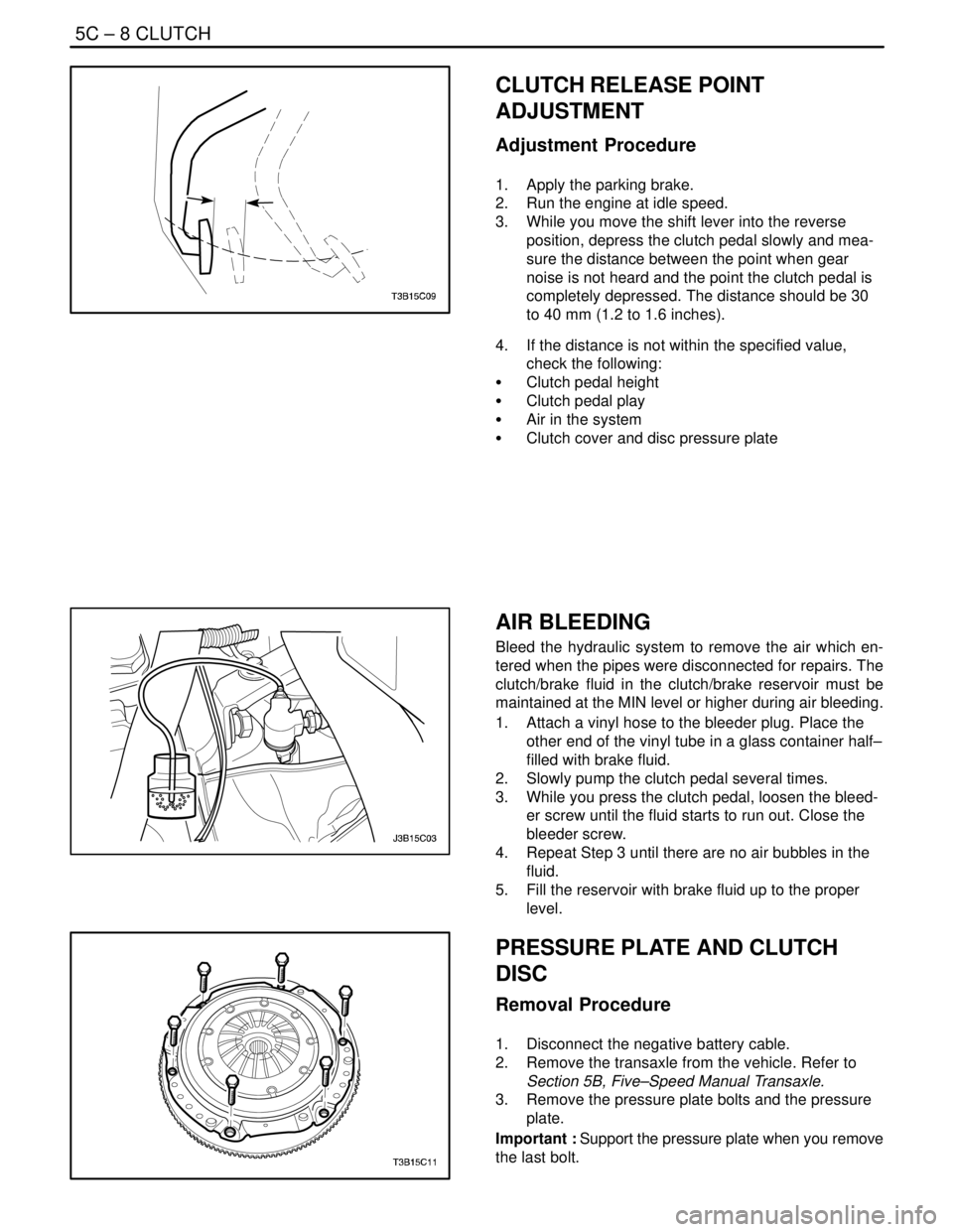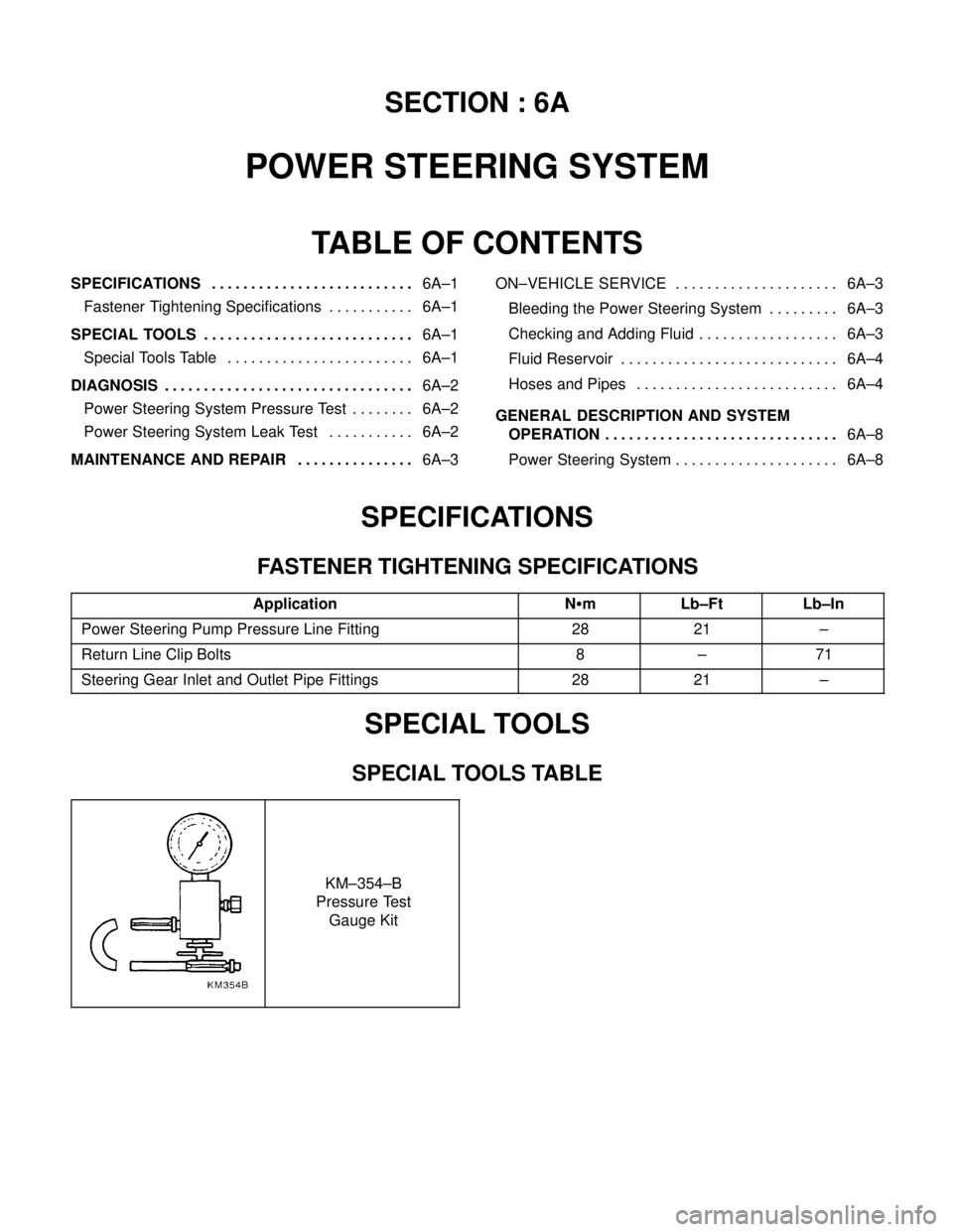Page 1887 of 2643
FIVE–SPEED MANUAL TRANSAXLE 5B – 63
DAEWOO V–121 BL4
GENERAL DESCRIPTION
AND SYSTEM OPERATION
FIVE–SPEED MANUAL TRANSAXLE
This five–speed transaxle assembly is a transmission of
constant–mesh design.
Combined in the assembly are:
S All forward gears.
S The reverse gear.
S The differential output.
The basic components of the five–speed transaxle as-
sembly units are the:
S Transaxle case.
S Input shaft.
S Input shaft gears.S Output shaft.
S Output shaft gears.
S Ring gear and differential assembly.
Forward Gear
Shifting to a forward gear is accomplished through a com-
bination of synchronizers with blocker rings controlled by
sliding shift forks.
Reverse Gear
Reverse gear is not synchronized and uses a sliding idler
gear arrangement.
Differential Assembly
The differential is a conventional arrangement of gears
that is supported by tapered roller bearings. The final out-
put gear turns the ring gear and differential assembly
which turns the drive axle shafts.
Page 1895 of 2643

5C – 8ICLUTCH
DAEWOO V–121 BL4
CLUTCH RELEASE POINT
ADJUSTMENT
Adjustment Procedure
1. Apply the parking brake.
2. Run the engine at idle speed.
3. While you move the shift lever into the reverse
position, depress the clutch pedal slowly and mea-
sure the distance between the point when gear
noise is not heard and the point the clutch pedal is
completely depressed. The distance should be 30
to 40 mm (1.2 to 1.6 inches).
4. If the distance is not within the specified value,
check the following:
S Clutch pedal height
S Clutch pedal play
S Air in the system
S Clutch cover and disc pressure plate
AIR BLEEDING
Bleed the hydraulic system to remove the air which en-
tered when the pipes were disconnected for repairs. The
clutch/brake fluid in the clutch/brake reservoir must be
maintained at the MIN level or higher during air bleeding.
1. Attach a vinyl hose to the bleeder plug. Place the
other end of the vinyl tube in a glass container half–
filled with brake fluid.
2. Slowly pump the clutch pedal several times.
3. While you press the clutch pedal, loosen the bleed-
er screw until the fluid starts to run out. Close the
bleeder screw.
4. Repeat Step 3 until there are no air bubbles in the
fluid.
5. Fill the reservoir with brake fluid up to the proper
level.
PRESSURE PLATE AND CLUTCH
DISC
Removal Procedure
1. Disconnect the negative battery cable.
2. Remove the transaxle from the vehicle. Refer to
Section 5B, Five–Speed Manual Transaxle.
3. Remove the pressure plate bolts and the pressure
plate.
Important : Support the pressure plate when you remove
the last bolt.
Page 1902 of 2643

SECTION : 6A
POWER STEERING SYSTEM
TABLE OF CONTENTS
SPECIFICATIONS6A–1 . . . . . . . . . . . . . . . . . . . . . . . . . .
Fastener Tightening Specifications 6A–1. . . . . . . . . . .
SPECIAL TOOLS6A–1 . . . . . . . . . . . . . . . . . . . . . . . . . . .
Special Tools Table 6A–1. . . . . . . . . . . . . . . . . . . . . . . .
DIAGNOSIS6A–2 . . . . . . . . . . . . . . . . . . . . . . . . . . . . . . . .
Power Steering System Pressure Test 6A–2. . . . . . . .
Power Steering System Leak Test 6A–2. . . . . . . . . . .
MAINTENANCE AND REPAIR6A–3 . . . . . . . . . . . . . . . ON–VEHICLE SERVICE 6A–3. . . . . . . . . . . . . . . . . . . . .
Bleeding the Power Steering System 6A–3. . . . . . . . .
Checking and Adding Fluid 6A–3. . . . . . . . . . . . . . . . . .
Fluid Reservoir 6A–4. . . . . . . . . . . . . . . . . . . . . . . . . . . .
Hoses and Pipes 6A–4. . . . . . . . . . . . . . . . . . . . . . . . . .
GENERAL DESCRIPTION AND SYSTEM
OPERATION6A–8 . . . . . . . . . . . . . . . . . . . . . . . . . . . . . .
Power Steering System 6A–8. . . . . . . . . . . . . . . . . . . . .
SPECIFICATIONS
FASTENER TIGHTENING SPECIFICATIONS
ApplicationNSmLb–FtLb–In
Power Steering Pump Pressure Line Fitting2821–
Return Line Clip Bolts8–71
Steering Gear Inlet and Outlet Pipe Fittings2821–
SPECIAL TOOLS
SPECIAL TOOLS TABLE
KM–354–B
Pressure Test
Gauge Kit
Page 1903 of 2643

6A – 2IPOWER STEERING SYSTEM
DAEWOO V–121 BL4
DIAGNOSIS
POWER STEERING SYSTEM
PRESSURE TEST
Tools Required
KM–354–B Pressure Test Gauge Kit
Check the fluid pressure as follows to determine whether
the trouble is in the pump or the gear unit.
Test Procedure
1. Check the power steering fluid level and the power
steering pump belt tension. Refer to ”Checking and
Adding Fluid” in this section and Section 6B, Power
Steering Pump.
2. Disconnect the high pressure line at the pump. Use
a small container to catch any fluid.
3. Connect the hose of the pressure test gauge kit
KM–354–B to the power steering pressure hose
from the power steering pump.
4. Place the gear selector lever in PARK (automatic
transaxle–equipped vehicles) or NEUTRAL (manual
transaxle–equipped vehicles). Set the parking
brake.
5. Open the gauge valve fully.
6. Start the engine and let it idle.
7. Turn the steering wheel from lock to lock several
times to warm the fluid to operating temperature.
8. Increase the engine speed to 1,500 rpm.
Notice : The power steering pump could be damaged if
the valve is fully closed for more than 5 seconds.
9. Close the gauge valve fully, and read the pressure.
The pump pressure with the valve closed should be
between 8,330 kPa to 8,820 kPa (1,208 psi to
1,279 psi). With electronic variable orifice, the pres-
sure should be between 8,500 kPa to 8,960 kPa
(1,233 psi to 1,299 psi).
10. Immediately open the gauge valve fully.
11. Turn the steering wheel all the way to the left and
the right. If the pressure is within the specified lim-
its, the problem is not in the pump. Check the pow-
er steering gear for leaks.
POWER STEERING SYSTEM LEAK
TEST
General Procedure
Inspect the following:
S The fluid reservoir for overfill.
S Fluid for aeration and overflow.
S The hoses for loose connections.
S The torsion bar, stub shaft and adjuster seals for
leaks.
S The component sealing surfaces for damage.
Important : Verify the exact point of the leak. The point
from which the fluid is dripping is not necessarily the point
at which the system is leaking. When service is required,
clean the leak area upon disassembly, replace the leaking
seal, check the component sealing surfaces for damage
and reset the torque bolt to specifications, where required.
External Leak Check
The purpose of this procedure is to pinpoint the location of
the leak. In some cases, the leak can be easily located, but
seepage–type leaks may be harder to find. To locate seep-
age leaks, use the following method:
1. With the engine off, wipe dry the complete power
steering system.
2. Check the power steering fluid level in the pump’s
reservoir. Adjust the fluid level as necessary. Refer
to ”Checking and Adding Fluid” in this section.
Notice : Do not hold the steering wheel at a stop for any
length of time as this can damage the power steering
pump.
3. Start the engine. Turn the steering wheel counter-
clockwise and clockwise from stop to stop several
times.
4. Find the exact area of the leak and repair it.
Page 1906 of 2643
POWER STEERING SYSTEM 6A – 5
DAEWOO V–121 BL4
3. Disconnect the return and supply line from the fluid
reservoir.
4. Loosen the retaining clip located above the alterna-
tor and position it away from the pressure line.
5. Raise and suitably support the vehicle.
6. Disconnect the pressure line from the power steer-
ing gear inlet.
7. Disconnect the return line outlet pipe from the pow-
er steering gear.
8. Remove the return line from the clip on the cross-
member.
Page 1907 of 2643
6A – 6IPOWER STEERING SYSTEM
DAEWOO V–121 BL4
9. Remove the bolts from each of the two clips on the
radiator.
10. Remove all the hoses and pipes from the vehicle.
11. Lower the vehicle.
Installation Procedure
1. Route the pressure line from the power steering
pump to the power steering gear.
2. Raise and suitably support the vehicle.
3. Route the return line from the fluid reservoir to the
power steering gear.
4. Install the two bolts on the radiator.
Tighten
Tighten the return line clip bolts to 8 NSm (71 lb–in).
5. Install the return line into the clip on the crossmem-
ber.
Tighten
Tighten the return line clip bolt to 8 NSm (71 lb–in).
6. Connect the return line to the power steering gear
outlet.
Tighten
Tighten the return line fitting to 28 NSm (21 lb–ft).
7. Connect the pressure line to the power steering
gear inlet.
Tighten
Tighten the pressure line fitting to 28 NSm (21 lb–ft).
Page 1909 of 2643

6A – 8IPOWER STEERING SYSTEM
DAEWOO V–121 BL4
GENERAL DESCRIPTION
AND SYSTEM OPERATION
POWER STEERING SYSTEM
General Description
The power steering system consists of three components:
the power steering pump, the power steering fluid reser-
voir and the the power steering rack and pinion gear. The
power steering pump is a vane–type pump providing hy-
draulic pressure for the system and is powered by the en-gine. It draws on the power steering fluid reservoir, which
in turn is connected to the power steering gear. A pres-
sure–relief valve inside the flow control valve limits the
pump pressure. The power steering rack and pinion gear
has a rotary control valve which directs hydraulic fluid
coming from the power steering pump to one side or the
other side of the rack piston. The integral rack piston is at-
tached to the rack. The rack piston converts hydraulic
pressure to a linear force which moves the rack to the left
or the right. The force is then transmitted through the inner
and the outer tie rods to the steering knuckles, which turn
the wheels.
Page 1911 of 2643

6B – 2IPOWER STEERING PUMP
DAEWOO V–121 BL4
DIAGNOSIS
POWER STEERING PUMP DIAGNOSIS
Foaming or Milky Power Steering Fluid (Air in Fluid)
ChecksAction
Check for internal leakage in the power steering pump,
causing an overflow.Repair the internal pump leakage.
Bleed the system.
Check for a low fluid level.Repair the internal pump leakage.
Bleed the system.
Cold temperatures will cause the air bubbles in the system
if the fluid level is low.
Low Pressure Due to Power Steering Pump
ChecksAction
Check for an external leakage of the power steering pump
at the seals.Replace the seals.
Repair the leak.
Bleed the system.
Check for a worn serpentine accessory drive belt.Replace the serpentine accessory drive belt.
Low Pressure Due to Power Steering Gear
ChecksAction
Check for a scored housing bore.Replace the housing bore.
Check for leakage at the valve rings or the seals.Repair the leak.
Bleed the system.
Groaning Noise in the Power Steering Pump
ChecksAction
Check for air in the power steering fluid.Perform the checks listed in ”Foaming or Milky Power
Steering Fluid (Air in Fluid)” above.
Check for a low level of power steering fluid.Repair any internal or external leaks.
Bleed the system.
Check for a loose mounting of the power steering pump.Tighten the pump mounting to specifications.